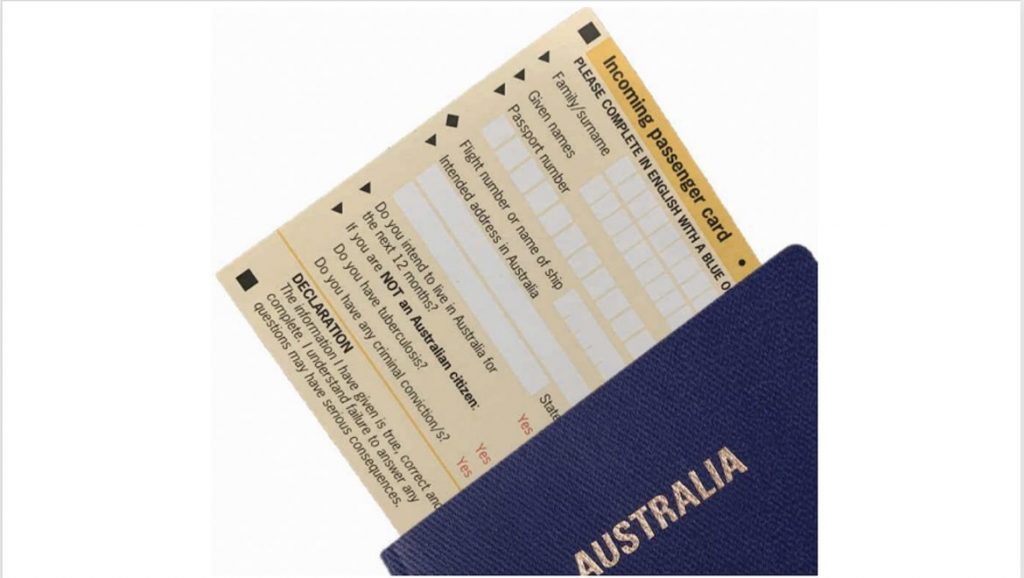
Rooting around in your bag for a pen to fill out inbound passenger cards could soon be a thing of the past after the federal government announced a $75 million deal to digitise immigration documentation.
The agreement with Dublin-based technology consulting firm Accenture has come as Australia plans ahead for post-COVID travel and so-called vaccine passports.
Under the deal, Accenture will introduce the Digital Passenger Declaration (DPD), which will take the place of the existing physical Incoming Passenger Card and COVID-19 Australian Travel Declaration Form.
The DPD will also collect and verify vital passenger information, including vaccination status, up to 72 hours prior to boarding, and will give passengers digital confirmation on their ability to travel to Australia.
According to the government, the DPD’s infrastructure could be expanded to later include visa documentation, import and export permits, licenses, and other government services.
Home Affairs Minister Karen Andrews said on Wednesday that the digital overhaul and the introduction of the DPD would allow for streamlined verification of COVID vaccination details, and allow for the “safe reopening of the border at scale”.
“This will help us to welcome home increasing numbers of Australians and welcome the tourists, travellers, international students, skilled workers and overseas friends and family we’ve all been missing during the pandemic,” Minister Andrews said.
The new system has been welcomed off the back of a new need for digital verification of vaccination status for international travel purposes, and comes after the government last year shelved a similar plan to outsource Australia’s visa processing system, despite spending nearly $92 million on the tender.
The new system, which will largely automise and digitise the whole border control process, will link up with Australia’s impending QR code vaccination certificate, due to be rolled out this month.
It is unclear how the new system will read and verify non-Australian vaccination certificates.
Passengers coming into Australia will reportedly be able to complete the DPD on their mobile device or computer, ahead of travel.
The DPD will move into a testing phase ahead of its rollout throughout Australia’s airports.
The news comes just days after the Australian government suggested it will lift its policy banning Australian citizens and residents from leaving the country as soon as November.
Prime Minister Scott Morrison has long suggested that Australia’s international borders will re-open once the country achieves an 80 per cent vaccination rate in its adult population, and that travel overseas will be exclusive to vaccinated travellers.
Currently, just over 40 per cent of Australia’s adult population is fully vaccinated.
Since March 2020, the federal government has imposed a ban on Australian citizens and residents leaving the country, unless they receive a valid exemption.
Trade Minister Dan Tehan said last week that restrictions for outbound international travel would be eased once vaccination targets are met, and specifically mentioned New Zealand, the Pacific, and Singapore as among the first destinations to be approved for travellers.
“The national plan makes very clear that once we hit that 80 per cent mark then outbound travel – travel by Australians overseas – will take place and also that we can put in place arrangements for inbound travel as well,” Minister Tehan said.
A spokesman for cabinet minister Stuart Robert said more details about Australia’s plan for re-opening international travel would be released shortly.
“The Morrison government continues to work towards vaccine assurance standards that will be one element of enabling vaccinated Australians to move and travel more freely,” he said.
It also comes after Qantas revealed it was gearing up to reintroduce part of its international network by December 2021, off the back of Australia’s current fast-paced vaccine rollout.
However, Qantas did note that the international re-opening is likely to be “gradual”, with a focus on low-risk countries first, including those with high vaccination uptake including the UK, US, and parts of Asia.
From mid-December, Qantas and Jetstar will reinstate international schedules between Australia and low-risk countries, including Singapore, the US, Japan, the UK, Canada and Fiji.
















Relieved
says:Thank goodness for that! It was an annoying thing to try to fill out, with nonsensical questions for returning Australians.
John Phillips
says:What about those with no smartphone?
Lot of elderly passengers don’t have one, and also a lot of people probably wouldn’t bring their phones to Australia, where they may not have arranged for an expensive roaming connection.
Rocket
says:About damn time……. ever since I first visited the United States, who are famous for having the most unfriendly and officious Immigration Officials, never needed to fill out the paperwork as in Australia – given we have quite appropriately strict quarantine regulations and that requires a declaration but the inbound and outbound passenger card(s) were both for nothing more than statistical purposes.
The I94 US card used to have just a local address and basic information. No outbound card as the check in agent would grip the stub of the inbound card, no outward passport control either. Check-in, go through security and board the flight, no endless queuing for superfluous departure processing at a congestion passport control area.
Old Person
says:What about people who do not have computers or mobile phones
Josef Stalin
says:Go get a phone. They’re not necessarily expensive and are very simple to use. Nothing to be afraid of and the kids at Apple are the very best.
Adrian P
says:The inbound passenger card is a statuary declaration regarding compliance of border regulations, a lot can happen in 72 hours. Also the card is used by border force for writing messages to the next official we get passed onto.
Then there is the cyber security issue and what happens when the system crashes.
Stand at a supermarket entrance and watch how many people are not using a QR code and then not signing in because there is no one at the customer service desk. Having another app is no substitution for not providing adequate resources.